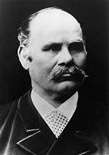Antti Ahlström

Antti Ahlström (7. November 1827, Merikarvia – 10. May 1896, Helsinki) founded the Ahlstrom Corporation. He was one of Finland's most influential and wealthy 19th century businessmen. In addition, Ahlström was an industrialist, ship owner, patron, commercial counselor and legislator.
Between 1866 and 1874, Antti Ahlström’s big business was shipping; he became the largest shipowner in Pori in 1871. It was in shipping that he earned the starting capital which he subsequently used to build his sawmill empire.
The purchase of the manor and iron works in Noormarkku in 1870 was a milestone in Antti Ahlström’s career: the purchase sealed his status as an important businessman and a ‘lord of the manor’. One month after the deed of sale was signed, his wife Margaretha Ahlström died of a sudden illness. In the following year, Antti Ahlström married again, this time to a woman 20 years his junior, Eva Holmström.[1]
Ahlström’s business grew rapidly due to major acquisitions, such as the iron works in Kauttua, Leineperi and Strömfors and the sawmills in Haminaholma, Suursaari and Tampere.
Antti Ahlström was a socially active citizen, representing the bourgeoisie of the Town of Pori at the Diet of the Estates in 1877-1878 and in 1894. He was awarded the highly distinguished honorary title of Commercial Counsellor in 1881. Ahlström and his wife made considerable donations to public schools and to public education to further the national interest, and to the arts, for instance to the Finnish National Theatre and the Finnish National Opera. The Ahlströms were also patrons to several Finnish artists, including Akseli Gallen-Kallela.[2]
When Antti Ahlström died on May 10, 1896, he left behind a fortune estimated at 11,4 million Finnish marks, which was Finland's largest at the time. Although difficult to estimate, this would likely be the equivalent of billions of Euro today.[1]
Antti Ahlström was a natural talent as a businessman and left an enormous industrial, ethical and secular legacy.
See also
References
- 1 2
- ↑
- Vierivä kivi opera Archived June 12, 2008, at the Wayback Machine.
External links
- Biografiskt lexikon för Finland (BLF): Antti Ahlström (Swedish)
- Ahlström, Antti Kansallisbiografia (Finnish)
- Vierivä kivi opera